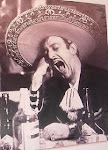- Peppy
Ok, so we have a mine and a smelter. We'll run trains back and forth. Oh goodie. Surely there has to be more than that? Of course there is!
In order to understand what our railroad does, let's make a flow chart of the industries and how they interact.
 Let's start with what we know. We know there is a mine and a smelter. So the silver ore moves from the mine to the smelter and they smelt it. Once they get the silver out, which is only a fraction of the rock that was brought there, they have tons of rock laying around. Maybe we can haul some of it back to the mine for fill dirt?
Let's start with what we know. We know there is a mine and a smelter. So the silver ore moves from the mine to the smelter and they smelt it. Once they get the silver out, which is only a fraction of the rock that was brought there, they have tons of rock laying around. Maybe we can haul some of it back to the mine for fill dirt? So, you ship silver ore to the smelter and they smelt it. Then what? Just sit on piles of silver? Oh no. They must have a customer!
So, you ship silver ore to the smelter and they smelt it. Then what? Just sit on piles of silver? Oh no. They must have a customer! The customer, represented by the cloud symbol, is off line. Probably a merchant of silver bullion or a jewelry manufacturer. Since we can't model the whole world, we'll say that the Mexican Central Railroad is the customer since they are so nice to take the silver off our hands in boxcars. Likewise, the smelter will need supplies. Smelting requires machinery, lubricants, fuel and lots of other commodities including chemicals. So the smelter becomes the customer of the MCRR. See how this works?
The customer, represented by the cloud symbol, is off line. Probably a merchant of silver bullion or a jewelry manufacturer. Since we can't model the whole world, we'll say that the Mexican Central Railroad is the customer since they are so nice to take the silver off our hands in boxcars. Likewise, the smelter will need supplies. Smelting requires machinery, lubricants, fuel and lots of other commodities including chemicals. So the smelter becomes the customer of the MCRR. See how this works? Well, what about the mine? They need supplies, too, because they have machinery and commodity needs. In that case, we'll add the mine supply warehouse. It will interface with the MCRR and accept deliveries for the mine. Now we have commerce going back and forth between all industries including our "invisible" industry, the MCRR.
Well, what about the mine? They need supplies, too, because they have machinery and commodity needs. In that case, we'll add the mine supply warehouse. It will interface with the MCRR and accept deliveries for the mine. Now we have commerce going back and forth between all industries including our "invisible" industry, the MCRR. I guess our locomotives are going to run on thin air or whatever Obama says they are allowed to run on, right? Incorecto, por favor! The mine and its trains run on black gold: oil. So we better provide them with some. We'll need a fuel oil distributor. Since the locos are going to buy this oil, we better set up the locomotive repair shop as an industry. We'll also send oil to the mine. To make things even more interesting, we are going to sell some bagged high-grade ore directly to the MCRR by way of boxcar.
I guess our locomotives are going to run on thin air or whatever Obama says they are allowed to run on, right? Incorecto, por favor! The mine and its trains run on black gold: oil. So we better provide them with some. We'll need a fuel oil distributor. Since the locos are going to buy this oil, we better set up the locomotive repair shop as an industry. We'll also send oil to the mine. To make things even more interesting, we are going to sell some bagged high-grade ore directly to the MCRR by way of boxcar. Of course you know that without people, the whole process stops. So we better figure out a way to get folks from off the railroad up to the mine since there are no Corvettes or Ferraris in 1900. Over the rugged mountain terrain even a mule will have a hard time, so we'll add some passenger service to our mix. We'll start by adding three stations, one "invisible" and off line, and the other two represented by real depots on the layout.
Of course you know that without people, the whole process stops. So we better figure out a way to get folks from off the railroad up to the mine since there are no Corvettes or Ferraris in 1900. Over the rugged mountain terrain even a mule will have a hard time, so we'll add some passenger service to our mix. We'll start by adding three stations, one "invisible" and off line, and the other two represented by real depots on the layout.There! We have a really good sketch of commerce on the railroad with key industries and supporting industries represented and an "off layout" world that we can interact with! Again, this is our sketch and we may change it later.



This is easily one of the most helpful (if not THE most helpful) piece I've read on planning a layout. I understood the concept of a real railroad moving freight, and those freights relating, but it never hit me to put it into a flowchart for planning purposes. I can already see the benefit to track planning this makes.
ReplyDelete